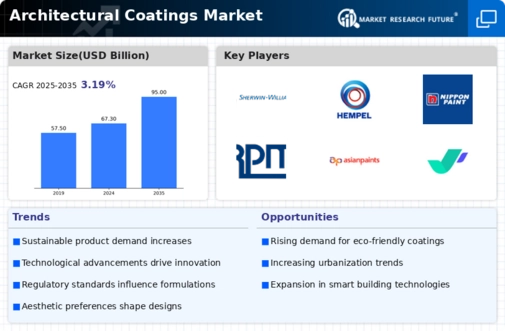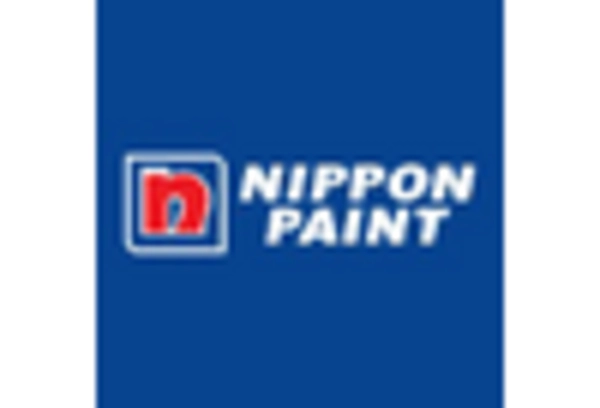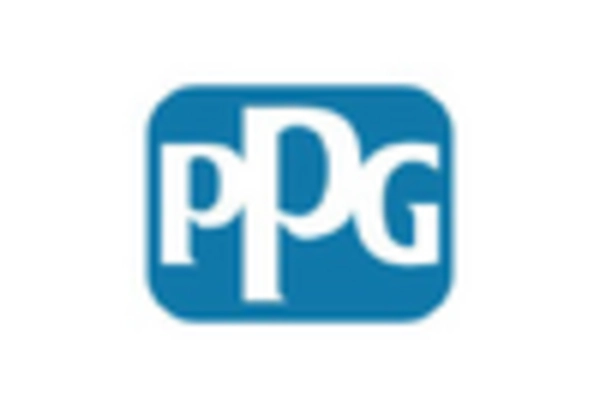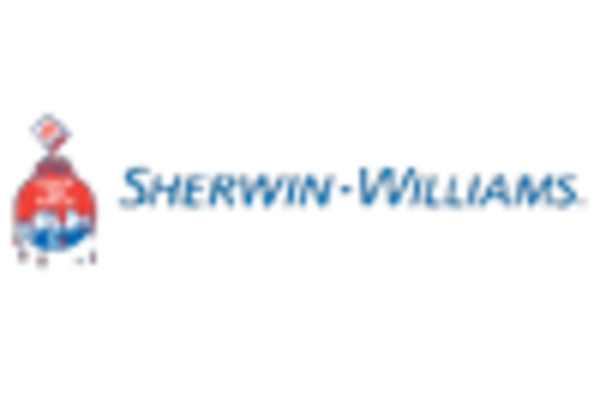Interior
Exterior
Protective Coatings
Specialty Coatings
Waterborne Coatings
Solventborne Coatings
Powder Coatings
UV-Cured Coatings
Acrylic
Alkyd
Polyurethane
Epoxy
Residential
Commercial
Industrial
Binders
Pigments
Additives
Solvents
North America
Europe
South America
Asia Pacific
Middle East and Africa
North America Outlook (USD Billion, 2019-2035)
North America Architectural Coatings Market by Application Type
Interior
Exterior
Protective Coatings
Specialty Coatings
North America Architectural Coatings Market by Type
Waterborne Coatings
Solventborne Coatings
Powder Coatings
UV-Cured Coatings
North America Architectural Coatings Market by Formulation Type
Acrylic
Alkyd
Polyurethane
Epoxy
North America Architectural Coatings Market by End Use Type
Residential
Commercial
Industrial
North America Architectural Coatings Market by Component Type
Binders
Pigments
Additives
Solvents
North America Architectural Coatings Market by Regional Type
US
Canada
US Outlook (USD Billion, 2019-2035)
US Architectural Coatings Market by Application Type
Interior
Exterior
Protective Coatings
Specialty Coatings
US Architectural Coatings Market by Type
Waterborne Coatings
Solventborne Coatings
Powder Coatings
UV-Cured Coatings
US Architectural Coatings Market by Formulation Type
Acrylic
Alkyd
Polyurethane
Epoxy
US Architectural Coatings Market by End Use Type
Residential
Commercial
Industrial
US Architectural Coatings Market by Component Type
Binders
Pigments
Additives
Solvents
CANADA Outlook (USD Billion, 2019-2035)
CANADA Architectural Coatings Market by Application Type
Interior
Exterior
Protective Coatings
Specialty Coatings
CANADA Architectural Coatings Market by Type
Waterborne Coatings
Solventborne Coatings
Powder Coatings
UV-Cured Coatings
CANADA Architectural Coatings Market by Formulation Type
Acrylic
Alkyd
Polyurethane
Epoxy
CANADA Architectural Coatings Market by End Use Type
Residential
Commercial
Industrial
CANADA Architectural Coatings Market by Component Type
Binders
Pigments
Additives
Solvents
Europe Outlook (USD Billion, 2019-2035)
Europe Architectural Coatings Market by Application Type
Interior
Exterior
Protective Coatings
Specialty Coatings
Europe Architectural Coatings Market by Type
Waterborne Coatings
Solventborne Coatings
Powder Coatings
UV-Cured Coatings
Europe Architectural Coatings Market by Formulation Type
Acrylic
Alkyd
Polyurethane
Epoxy
Europe Architectural Coatings Market by End Use Type
Residential
Commercial
Industrial
Europe Architectural Coatings Market by Component Type
Binders
Pigments
Additives
Solvents
Europe Architectural Coatings Market by Regional Type
Germany
UK
France
Russia
Italy
Spain
Rest of Europe
GERMANY Outlook (USD Billion, 2019-2035)
GERMANY Architectural Coatings Market by Application Type
Interior
Exterior
Protective Coatings
Specialty Coatings
GERMANY Architectural Coatings Market by Type
Waterborne Coatings
Solventborne Coatings
Powder Coatings
UV-Cured Coatings
GERMANY Architectural Coatings Market by Formulation Type
Acrylic
Alkyd
Polyurethane
Epoxy
GERMANY Architectural Coatings Market by End Use Type
Residential
Commercial
Industrial
GERMANY Architectural Coatings Market by Component Type
Binders
Pigments
Additives
Solvents
UK Outlook (USD Billion, 2019-2035)
UK Architectural Coatings Market by Application Type
Interior
Exterior
Protective Coatings
Specialty Coatings
UK Architectural Coatings Market by Type
Waterborne Coatings
Solventborne Coatings
Powder Coatings
UV-Cured Coatings
UK Architectural Coatings Market by Formulation Type
Acrylic
Alkyd
Polyurethane
Epoxy
UK Architectural Coatings Market by End Use Type
Residential
Commercial
Industrial
UK Architectural Coatings Market by Component Type
Binders
Pigments
Additives
Solvents
FRANCE Outlook (USD Billion, 2019-2035)
FRANCE Architectural Coatings Market by Application Type
Interior
Exterior
Protective Coatings
Specialty Coatings
FRANCE Architectural Coatings Market by Type
Waterborne Coatings
Solventborne Coatings
Powder Coatings
UV-Cured Coatings
FRANCE Architectural Coatings Market by Formulation Type
Acrylic
Alkyd
Polyurethane
Epoxy
FRANCE Architectural Coatings Market by End Use Type
Residential
Commercial
Industrial
FRANCE Architectural Coatings Market by Component Type
Binders
Pigments
Additives
Solvents
RUSSIA Outlook (USD Billion, 2019-2035)
RUSSIA Architectural Coatings Market by Application Type
Interior
Exterior
Protective Coatings
Specialty Coatings
RUSSIA Architectural Coatings Market by Type
Waterborne Coatings
Solventborne Coatings
Powder Coatings
UV-Cured Coatings
RUSSIA Architectural Coatings Market by Formulation Type
Acrylic
Alkyd
Polyurethane
Epoxy
RUSSIA Architectural Coatings Market by End Use Type
Residential
Commercial
Industrial
RUSSIA Architectural Coatings Market by Component Type
Binders
Pigments
Additives
Solvents
ITALY Outlook (USD Billion, 2019-2035)
ITALY Architectural Coatings Market by Application Type
Interior
Exterior
Protective Coatings
Specialty Coatings
ITALY Architectural Coatings Market by Type
Waterborne Coatings
Solventborne Coatings
Powder Coatings
UV-Cured Coatings
ITALY Architectural Coatings Market by Formulation Type
Acrylic
Alkyd
Polyurethane
Epoxy
ITALY Architectural Coatings Market by End Use Type
Residential
Commercial
Industrial
ITALY Architectural Coatings Market by Component Type
Binders
Pigments
Additives
Solvents
SPAIN Outlook (USD Billion, 2019-2035)
SPAIN Architectural Coatings Market by Application Type
Interior
Exterior
Protective Coatings
Specialty Coatings
SPAIN Architectural Coatings Market by Type
Waterborne Coatings
Solventborne Coatings
Powder Coatings
UV-Cured Coatings
SPAIN Architectural Coatings Market by Formulation Type
Acrylic
Alkyd
Polyurethane
Epoxy
SPAIN Architectural Coatings Market by End Use Type
Residential
Commercial
Industrial
SPAIN Architectural Coatings Market by Component Type
Binders
Pigments
Additives
Solvents
REST OF EUROPE Outlook (USD Billion, 2019-2035)
REST OF EUROPE Architectural Coatings Market by Application Type
Interior
Exterior
Protective Coatings
Specialty Coatings
REST OF EUROPE Architectural Coatings Market by Type
Waterborne Coatings
Solventborne Coatings
Powder Coatings
UV-Cured Coatings
REST OF EUROPE Architectural Coatings Market by Formulation Type
Acrylic
Alkyd
Polyurethane
Epoxy
REST OF EUROPE Architectural Coatings Market by End Use Type
Residential
Commercial
Industrial
REST OF EUROPE Architectural Coatings Market by Component Type
Binders
Pigments
Additives
Solvents
APAC Outlook (USD Billion, 2019-2035)
APAC Architectural Coatings Market by Application Type
Interior
Exterior
Protective Coatings
Specialty Coatings
APAC Architectural Coatings Market by Type
Waterborne Coatings
Solventborne Coatings
Powder Coatings
UV-Cured Coatings
APAC Architectural Coatings Market by Formulation Type
Acrylic
Alkyd
Polyurethane
Epoxy
APAC Architectural Coatings Market by End Use Type
Residential
Commercial
Industrial
APAC Architectural Coatings Market by Component Type
Binders
Pigments
Additives
Solvents
APAC Architectural Coatings Market by Regional Type
China
India
Japan
South Korea
Malaysia
Thailand
Indonesia
Rest of APAC
CHINA Outlook (USD Billion, 2019-2035)
CHINA Architectural Coatings Market by Application Type
Interior
Exterior
Protective Coatings
Specialty Coatings
CHINA Architectural Coatings Market by Type
Waterborne Coatings
Solventborne Coatings
Powder Coatings
UV-Cured Coatings
CHINA Architectural Coatings Market by Formulation Type
Acrylic
Alkyd
Polyurethane
Epoxy
CHINA Architectural Coatings Market by End Use Type
Residential
Commercial
Industrial
CHINA Architectural Coatings Market by Component Type
Binders
Pigments
Additives
Solvents
INDIA Outlook (USD Billion, 2019-2035)
INDIA Architectural Coatings Market by Application Type
Interior
Exterior
Protective Coatings
Specialty Coatings
INDIA Architectural Coatings Market by Type
Waterborne Coatings
Solventborne Coatings
Powder Coatings
UV-Cured Coatings
INDIA Architectural Coatings Market by Formulation Type
Acrylic
Alkyd
Polyurethane
Epoxy
INDIA Architectural Coatings Market by End Use Type
Residential
Commercial
Industrial
INDIA Architectural Coatings Market by Component Type
Binders
Pigments
Additives
Solvents
JAPAN Outlook (USD Billion, 2019-2035)
JAPAN Architectural Coatings Market by Application Type
Interior
Exterior
Protective Coatings
Specialty Coatings
JAPAN Architectural Coatings Market by Type
Waterborne Coatings
Solventborne Coatings
Powder Coatings
UV-Cured Coatings
JAPAN Architectural Coatings Market by Formulation Type
Acrylic
Alkyd
Polyurethane
Epoxy
JAPAN Architectural Coatings Market by End Use Type
Residential
Commercial
Industrial
JAPAN Architectural Coatings Market by Component Type
Binders
Pigments
Additives
Solvents
SOUTH KOREA Outlook (USD Billion, 2019-2035)
SOUTH KOREA Architectural Coatings Market by Application Type
Interior
Exterior
Protective Coatings
Specialty Coatings
SOUTH KOREA Architectural Coatings Market by Type
Waterborne Coatings
Solventborne Coatings
Powder Coatings
UV-Cured Coatings
SOUTH KOREA Architectural Coatings Market by Formulation Type
Acrylic
Alkyd
Polyurethane
Epoxy
SOUTH KOREA Architectural Coatings Market by End Use Type
Residential
Commercial
Industrial
SOUTH KOREA Architectural Coatings Market by Component Type
Binders
Pigments
Additives
Solvents
MALAYSIA Outlook (USD Billion, 2019-2035)
MALAYSIA Architectural Coatings Market by Application Type
Interior
Exterior
Protective Coatings
Specialty Coatings
MALAYSIA Architectural Coatings Market by Type
Waterborne Coatings
Solventborne Coatings
Powder Coatings
UV-Cured Coatings
MALAYSIA Architectural Coatings Market by Formulation Type
Acrylic
Alkyd
Polyurethane
Epoxy
MALAYSIA Architectural Coatings Market by End Use Type
Residential
Commercial
Industrial
MALAYSIA Architectural Coatings Market by Component Type
Binders
Pigments
Additives
Solvents
THAILAND Outlook (USD Billion, 2019-2035)
THAILAND Architectural Coatings Market by Application Type
Interior
Exterior
Protective Coatings
Specialty Coatings
THAILAND Architectural Coatings Market by Type
Waterborne Coatings
Solventborne Coatings
Powder Coatings
UV-Cured Coatings
THAILAND Architectural Coatings Market by Formulation Type
Acrylic
Alkyd
Polyurethane
Epoxy
THAILAND Architectural Coatings Market by End Use Type
Residential
Commercial
Industrial
THAILAND Architectural Coatings Market by Component Type
Binders
Pigments
Additives
Solvents
INDONESIA Outlook (USD Billion, 2019-2035)
INDONESIA Architectural Coatings Market by Application Type
Interior
Exterior
Protective Coatings
Specialty Coatings
INDONESIA Architectural Coatings Market by Type
Waterborne Coatings
Solventborne Coatings
Powder Coatings
UV-Cured Coatings
INDONESIA Architectural Coatings Market by Formulation Type
Acrylic
Alkyd
Polyurethane
Epoxy
INDONESIA Architectural Coatings Market by End Use Type
Residential
Commercial
Industrial
INDONESIA Architectural Coatings Market by Component Type
Binders
Pigments
Additives
Solvents
REST OF APAC Outlook (USD Billion, 2019-2035)
REST OF APAC Architectural Coatings Market by Application Type
Interior
Exterior
Protective Coatings
Specialty Coatings
REST OF APAC Architectural Coatings Market by Type
Waterborne Coatings
Solventborne Coatings
Powder Coatings
UV-Cured Coatings
REST OF APAC Architectural Coatings Market by Formulation Type
Acrylic
Alkyd
Polyurethane
Epoxy
REST OF APAC Architectural Coatings Market by End Use Type
Residential
Commercial
Industrial
REST OF APAC Architectural Coatings Market by Component Type
Binders
Pigments
Additives
Solvents
South America Outlook (USD Billion, 2019-2035)
South America Architectural Coatings Market by Application Type
Interior
Exterior
Protective Coatings
Specialty Coatings
South America Architectural Coatings Market by Type
Waterborne Coatings
Solventborne Coatings
Powder Coatings
UV-Cured Coatings
South America Architectural Coatings Market by Formulation Type
Acrylic
Alkyd
Polyurethane
Epoxy
South America Architectural Coatings Market by End Use Type
Residential
Commercial
Industrial
South America Architectural Coatings Market by Component Type
Binders
Pigments
Additives
Solvents
South America Architectural Coatings Market by Regional Type
Brazil
Mexico
Argentina
Rest of South America
BRAZIL Outlook (USD Billion, 2019-2035)
BRAZIL Architectural Coatings Market by Application Type
Interior
Exterior
Protective Coatings
Specialty Coatings
BRAZIL Architectural Coatings Market by Type
Waterborne Coatings
Solventborne Coatings
Powder Coatings
UV-Cured Coatings
BRAZIL Architectural Coatings Market by Formulation Type
Acrylic
Alkyd
Polyurethane
Epoxy
BRAZIL Architectural Coatings Market by End Use Type
Residential
Commercial
Industrial
BRAZIL Architectural Coatings Market by Component Type
Binders
Pigments
Additives
Solvents
MEXICO Outlook (USD Billion, 2019-2035)
MEXICO Architectural Coatings Market by Application Type
Interior
Exterior
Protective Coatings
Specialty Coatings
MEXICO Architectural Coatings Market by Type
Waterborne Coatings
Solventborne Coatings
Powder Coatings
UV-Cured Coatings
MEXICO Architectural Coatings Market by Formulation Type
Acrylic
Alkyd
Polyurethane
Epoxy
MEXICO Architectural Coatings Market by End Use Type
Residential
Commercial
Industrial
MEXICO Architectural Coatings Market by Component Type
Binders
Pigments
Additives
Solvents
ARGENTINA Outlook (USD Billion, 2019-2035)
ARGENTINA Architectural Coatings Market by Application Type
Interior
Exterior
Protective Coatings
Specialty Coatings
ARGENTINA Architectural Coatings Market by Type
Waterborne Coatings
Solventborne Coatings
Powder Coatings
UV-Cured Coatings
ARGENTINA Architectural Coatings Market by Formulation Type
Acrylic
Alkyd
Polyurethane
Epoxy
ARGENTINA Architectural Coatings Market by End Use Type
Residential
Commercial
Industrial
ARGENTINA Architectural Coatings Market by Component Type
Binders
Pigments
Additives
Solvents
REST OF SOUTH AMERICA Outlook (USD Billion, 2019-2035)
REST OF SOUTH AMERICA Architectural Coatings Market by Application Type
Interior
Exterior
Protective Coatings
Specialty Coatings
REST OF SOUTH AMERICA Architectural Coatings Market by Type
Waterborne Coatings
Solventborne Coatings
Powder Coatings
UV-Cured Coatings
REST OF SOUTH AMERICA Architectural Coatings Market by Formulation Type
Acrylic
Alkyd
Polyurethane
Epoxy
REST OF SOUTH AMERICA Architectural Coatings Market by End Use Type
Residential
Commercial
Industrial
REST OF SOUTH AMERICA Architectural Coatings Market by Component Type
Binders
Pigments
Additives
Solvents
MEA Outlook (USD Billion, 2019-2035)
MEA Architectural Coatings Market by Application Type
Interior
Exterior
Protective Coatings
Specialty Coatings
MEA Architectural Coatings Market by Type
Waterborne Coatings
Solventborne Coatings
Powder Coatings
UV-Cured Coatings
MEA Architectural Coatings Market by Formulation Type
Acrylic
Alkyd
Polyurethane
Epoxy
MEA Architectural Coatings Market by End Use Type
Residential
Commercial
Industrial
MEA Architectural Coatings Market by Component Type
Binders
Pigments
Additives
Solvents
MEA Architectural Coatings Market by Regional Type
GCC Countries
South Africa
Rest of MEA
GCC COUNTRIES Outlook (USD Billion, 2019-2035)
GCC COUNTRIES Architectural Coatings Market by Application Type
Interior
Exterior
Protective Coatings
Specialty Coatings
GCC COUNTRIES Architectural Coatings Market by Type
Waterborne Coatings
Solventborne Coatings
Powder Coatings
UV-Cured Coatings
GCC COUNTRIES Architectural Coatings Market by Formulation Type
Acrylic
Alkyd
Polyurethane
Epoxy
GCC COUNTRIES Architectural Coatings Market by End Use Type
Residential
Commercial
Industrial
GCC COUNTRIES Architectural Coatings Market by Component Type
Binders
Pigments
Additives
Solvents
SOUTH AFRICA Outlook (USD Billion, 2019-2035)
SOUTH AFRICA Architectural Coatings Market by Application Type
Interior
Exterior
Protective Coatings
Specialty Coatings
SOUTH AFRICA Architectural Coatings Market by Type
Waterborne Coatings
Solventborne Coatings
Powder Coatings
UV-Cured Coatings
SOUTH AFRICA Architectural Coatings Market by Formulation Type
Acrylic
Alkyd
Polyurethane
Epoxy
SOUTH AFRICA Architectural Coatings Market by End Use Type
Residential
Commercial
Industrial
SOUTH AFRICA Architectural Coatings Market by Component Type
Binders
Pigments
Additives
Solvents
REST OF MEA Outlook (USD Billion, 2019-2035)
REST OF MEA Architectural Coatings Market by Application Type
Interior
Exterior
Protective Coatings
Specialty Coatings
REST OF MEA Architectural Coatings Market by Type
Waterborne Coatings
Solventborne Coatings
Powder Coatings
UV-Cured Coatings
REST OF MEA Architectural Coatings Market by Formulation Type
Acrylic
Alkyd
Polyurethane
Epoxy
REST OF MEA Architectural Coatings Market by End Use Type
Residential
Commercial
Industrial
REST OF MEA Architectural Coatings Market by Component Type
Binders
Pigments
Additives
Solvents

















Leave a Comment